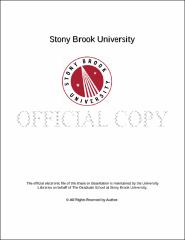| dc.identifier.uri | http://hdl.handle.net/11401/77290 | |
| dc.description.sponsorship | This work is sponsored by the Stony Brook University Graduate School in compliance with the requirements for completion of degree. | en_US |
| dc.format | Monograph | |
| dc.format.medium | Electronic Resource | en_US |
| dc.language.iso | en_US | |
| dc.publisher | The Graduate School, Stony Brook University: Stony Brook, NY. | |
| dc.type | Dissertation | |
| dcterms.abstract | An active area of Future Internet Architectures research is Information Centric Networking (ICNs). Content Centric Networking (CCN) is one of the widely known ICN proposals. ICNs propose a communication paradigm in which named content is the focal point. A fundamental component of ICNs is “in-network caching†, whereby routers act as content caches. The routers implement a “forwarding strategy†for packets that makes intelligent decisions taking several factors into account, not the least of which is leveraging the presence of cached content in the network. From early on, two basic forwarding strategies were proposed for CCN, CCN-Flooding and CCN-Publication. We present a performance study of CCN-Flooding and CCN-Publication behavior and bandwidth consumption. We analyze the interplay between two important components of CCN, in-network caches and the Pending Interest Table (PIT), under CCN-Publication. We show that the effect of PIT aggregation increases commensurately with network load and the Betweenness Centrality attribute of the network topology. While both PIT aggregation and in-network caching contribute significantly to savings in network bandwidth consumption, we show that they do not do so in an additive fashion. As network load increases, gains from cache hits diminish and are replaced by gains from PIT aggregation, without dramatically impacting the level of overall savings achieved. We also identify and analyze various issues pertaining to CCN-Flooding, such as calibration of PIT timeouts; a PIT-induced isolation effect that negatively impacts bandwidth consumption and response time; and the effects of adopting FIB routes based on volatile in-network cache entries. Finally, we analyze CCN-Publication taking into account, unlike the current research literature, the bandwidth costs of populating the FIBs, and compare that to CCN-Flooding. Next, we propose a new lightweight forwarding strategy for CCN. One of the primary objectives for a forwarding strategy is to improve user experience by exploiting in-network caching, while minimizing the associated costs. To this effect, we compare the new forwarding strategy, called CCN-FOH, against CCN-Publication and CCN-Flooding. The results show that CCN-FOH provides for a better user experience while keeping its overheads comparable to, if not better than, the less costly CCN-Publication. | |
| dcterms.available | 2017-09-20T16:52:21Z | |
| dcterms.contributor | Badr, Hussein G | en_US |
| dcterms.contributor | Das, Samir | en_US |
| dcterms.contributor | Robertazzi, Thomas | en_US |
| dcterms.contributor | Liu, Ellen. | en_US |
| dcterms.creator | Kazi, Ahmed Waliullah | |
| dcterms.dateAccepted | 2017-09-20T16:52:21Z | |
| dcterms.dateSubmitted | 2017-09-20T16:52:21Z | |
| dcterms.description | Department of Computer Science. | en_US |
| dcterms.extent | 122 pg. | en_US |
| dcterms.format | Monograph | |
| dcterms.format | Application/PDF | en_US |
| dcterms.identifier | http://hdl.handle.net/11401/77290 | |
| dcterms.issued | 2015-12-01 | |
| dcterms.language | en_US | |
| dcterms.provenance | Made available in DSpace on 2017-09-20T16:52:21Z (GMT). No. of bitstreams: 1
Kazi_grad.sunysb_0771E_12554.pdf: 3074135 bytes, checksum: 44aac5c62010431593ccb07357c53e67 (MD5)
Previous issue date: 1 | en |
| dcterms.publisher | The Graduate School, Stony Brook University: Stony Brook, NY. | |
| dcterms.subject | Computer science | |
| dcterms.subject | Content Centric Networking, Forwarding Strategies in CCN, Future Internet Architectures, Information Centric Networking | |
| dcterms.title | CCN Forwarding Strategies | |
| dcterms.type | Dissertation | |

